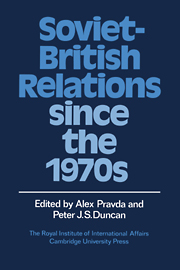Book contents
- Frontmatter
- Contents
- Contributors
- Acknowledgments
- 1 Introduction: pre-perestroika patterns
- 2 The historical perspective
- 3 Soviet perspectives on Britain and British foreign policy
- 4 British perspectives on the Soviet Union
- 5 The security dimension
- 6 Anglo-Soviet relations: political and diplomatic
- 7 The Soviet Union and the Left in Britain
- 8 Anglo-Soviet cultural contacts since 1975
- 9 Trade relations: patterns and prospects
- 10 Doing business with the USSR
- 11 Conclusions: Soviet-British relations under perestroika
- Index
2 - The historical perspective
Published online by Cambridge University Press: 29 October 2009
- Frontmatter
- Contents
- Contributors
- Acknowledgments
- 1 Introduction: pre-perestroika patterns
- 2 The historical perspective
- 3 Soviet perspectives on Britain and British foreign policy
- 4 British perspectives on the Soviet Union
- 5 The security dimension
- 6 Anglo-Soviet relations: political and diplomatic
- 7 The Soviet Union and the Left in Britain
- 8 Anglo-Soviet cultural contacts since 1975
- 9 Trade relations: patterns and prospects
- 10 Doing business with the USSR
- 11 Conclusions: Soviet-British relations under perestroika
- Index
Summary
In December 1917 the British War Cabinet confronted the problem raised by the October Revolution in Russia: whether to come out in open opposition to the Bolsheviks or to make the best deal possible with them. Balfour summed up his policy in the memorable phrase: ‘If this be drifting, then I am a drifter by deliberate policy‘ - and his colleagues were content to leave the dilemma unresolved. Over the next seventy years, and frequently in the most critical international situations, successive British Governments were to be confronted by the same problem. They did not always drift. From David Lloyd George to Margaret Thatcher, Prime Ministers placed their personal imprint upon policy. Trade agreements were made, unmade and remade. Diplomatic relations were established, broken and re-established. Political dialogue was initiated, interrupted and restarted. Policies were pursued which at one extreme brought Britain and the Soviet Union into open military conflict and at the other into formal military alliance. The relationship was rarely symmetrical. By the time the revolutionaries of 1917 had created the world's second superpower, Britain had declined from the zenith of imperial power and, within the context of this evolving power ratio, the problem of achieving a stable and satisfactory British-Soviet relationship remained unsolved.
Now with a new Soviet leadership pursuing a policy of ‘reconstruction’ and exercising a more flexible and sophisticated diplomacy, a new phase in the relationship may be opening. The purpose of the present chapter is to set that phase in the context of earlier phases in British-Soviet relations as they have developed since 1917. It is written from a British standpoint.
- Type
- Chapter
- Information
- Soviet-British Relations since the 1970s , pp. 17 - 46Publisher: Cambridge University PressPrint publication year: 1990
- 1
- Cited by



